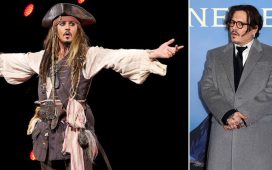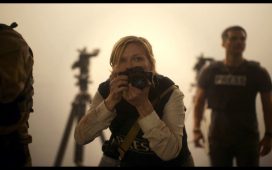Had D.A. Pennebaker never done anything but hop a flight to London, 16mm camera in tow, and follow around a scrawny young singer who jousted with journalists, was worshipped as a frizzy-haired god and entertained himself with entourage-fueled shenanigans, he would still have secured himself a place in rock history and film history. The best-known picture of the documentarian, known as “Penny” to friends and colleagues, finds the then-39-year-old wearing a top hat, jauntily tilted to one side. A camera is hoisted on his shoulder, covering one half of his face. His left index finger is pointing up and placed in front of his eye. He’s in the background, right where he always wanted to be. He looks happy to have a ringside seat to history being made. Sitting right in front of him, uncharacteristically in focus, is his subject: the ’65 edition of Bob Dylan.
We take it for granted now that Dont Look Back, the chronicle of Dylan confronting the modern celebrity game and giving it the Bronx cheer, is the definitive look at the troubadour poised between reluctant prophet and full-on rock star. It took Pennebaker two years to get anyone to show the film in public; he eventually found a porn-theater operator in San Francisco to give it a screen in a small moviehouse, where it ran for over a year. The litany of put-ons and put-downs captured on film still drop jaws. The all-access pass we get still feels thrillingly, and sometimes uncomfortably intimate. (See: Donovan.) You are there in the Royal Albert Hall’s audience as he plays. You are there in the backrooms as Albert Grossman negotiates deals and in the middle of entourage banter. You are there next to Dylan, getting impatient with reporters, goofing with Joan Baez and Bob Neuwirth, and almost catching up to that thin, mercurial sound he was chasing. You are there because Pennebaker was there.
The filmmaker, who died of natural causes on August 1st at the age of 94, had a knack for being at the right place at the right time, his finger on the Arriflex trigger. He knew that the closer you could get, and the more you could blend into the scenery so the subject forgot you were there, the more likely you were to capture something akin to truth 24 frames per second. Donn Alan Pennebaker had originally studied to be an engineer before a brief apprenticeship with Francis Thompson led him to nonfiction filmmaking. Early works, like Daybreak Express (1953) and Baby (1954) were essentially experimental shorts, with the former demonstrating a nice blend of music and image and the latter proving to D.A. that, in his own words, “I should be watching, not directing.”
Soon, he’d join a documentarian murder’s row — Robert Drew, Richard Leacock, Albert Maysles, Terence Macartney-Filgate — and help form a filmmaking unit at Time Inc. Works like Primary (1960) and Crisis (1963) aren’t just Kennedy-era political time capsules. They helped give birth to an entirely new form of observational moviemaking, often dubbed “direct cinema.” They are Documentary 2.0’s ground zero. “[President Kennedy] never saw us as the six o’clock news,” Pennebaker would say at a panel in 2016. “We were history cameras.”
Part of the reason Drew & Co. were able to capture moments on the fly was thanks to a technological innovation that Pennebaker helped initiate, in the form of a new camera that could sync-sound with images much more efficiently. (They made Life magazine foot the bill.) He’d further customize his weapon of choice when he went off his own, making it more lightweight and adding a grip that could allow someone to mount it on their shoulder. That’s the camera you see in that famous Dont Look Back shot. That’s the one he’d bring to Monterey International Pop Music Festival in 1967, loaded with new high-speed film, when he was invited to cover the event, resulting in Monterey Pop (1968), widely recognized as the first modern concert movie. (Jazz on a Summer’s Day came in 1959, but this was a whole new ballgame.) Hendrix setting his guitar on fire. The Who smashing their gear. Otis Redding and Janis Joplin, in all of their ragged soul-shouting glory. Mama Cass fangirling out and Mickey Dolenz bopping blissfully to Ravi Shankar. Welcome to the Sixties. Have a nice trip.
Pennebaker’s music docs — god, those music docs. They form their own separate canon. Penny was there at the Hammersmith Odeon in 1973 when David Bowie performed the final Ziggy Stardust concert, which is why we can still thrill to see the performer in his silver spaceman tunic singing about leper messiahs and rock & roll suicides. (Ziggy Stardust and the Spiders From Mars, 1973.) He was in Toronto in 1969 when John Lennon performed alongside Little Richard, Eric Clapton and Bo Diddly. (John Lennon and the Plastic Ono Band: Sweet Toronto, 1971.) He and his longtime professional/life partner Chris Hegedus were at the Rose Bowl in 1988 when Depeche Mode finished off their Music for the Masses tour (Depeche Mode 101, 1989.) in Pasadena and at the Ryman in Nashville, Tennessee in 2000 when Emmylou Harris, Gillian Welch and more perform old-timey cuts from the bestselling bluegrass soundtrack to O Brother Where Art Thou? (Down From the Mountain, 2000.)
What strikes you the most about these movies aren’t just the grand performances but the smaller, off-the-cuff moments he gets from these famous people: Dylan typing away in London; Mama Cass mouthing “wow!” after “Ball and Chain”; Bowie joking with his wife Angie about make-up; T-Bone Burnett trying to get a bluegrass guitarist, of all folks, to speed up a tempo; Dave Gahan singing along to Roxy. Music’s “Love Is the Drug” while playing pinball. And with Depeche Mode 101, Pennebaker and Hegedus had the foresight to embed cameramen on a bus that was taking a gaggle of teen-to-twentysomething superfans across the country to that Rose Bowl show, capturing all of their interactions and arguments and drunken revelry. What happens, in other words, when people stop singing the lyrics to “Stripped” and start getting real? An IRL star is born. Three years later, MTV’s The Real Word would codify the notion into an industry.
That combination of putting you in the middle of something as a spectator and behind the scenes as a participant simultaneously wasn’t just confined to his music-related projects. Town Bloody Hall (1979) — the unsung gem of his vital filmography — watches as Norman Mailer and a who’s who of second-wave feminists spar in a 1971 intellectual summit in New York City. It took Hegedus convincing D.A. that the footage, which they’d been sitting on for years, could actually be cobbled together in to something usable; to watch this verité masterpiece today is both a thrilling time warp and a sobering reminder that plus ça change, etc. The War Room (1993) drops you in the room where it happens as Bill Clinton and his strategists, including George Stephanopoulos and the ragin’ Cajun himself, James Carville, plot his presidential campaign — you won’t find a more insightful look at how the political sausage gets made in the ‘90s and how that was continuously morphing before our eyes. Original Cast Album: Company (1970) catches every bitchy, bleary-eyed, brilliant moment of Stephen Sondheim and the late, great Hal Prince putting the cast members of the Tony-winning play through their soundtrack-recording paces. The fact that people are catching up to this singular cringe-comic doc thanks to Documentary Now‘s pitch-perfect parody feels like major win-win.
This is what great observational documentarians do: They capture something large in the foreground and something telling in the periphery, preserving everything in amber yet making it all feel so alive. This is what Pennebaker did throughout his career, from the very beginning up until the end, as his last film Unlocking the Cage — a 2016 portrait of the animal-rights activist Stephen M. Wise that he co-directed with Hegedus — can attest. His contributions regarding how we look at the history of the later half of the 29th century is profound. His impact on nonfiction filmmaking isn’t just invaluable but unfathomable. “If a new generation of filmmakers is going to be interested in the film form called ‘documentary,’” he notes in the book Imagining Reality, “it will only be because it throws off new sparks, not old news.” Pennebaker turned that concept into a genuine reality every time he turned on a camera and pointed. And each time he did it, he never looked back.













